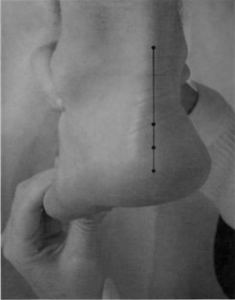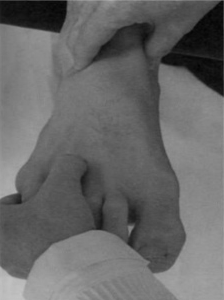Orthopedic Exam / Special Tests for Physical Therapy: Leg & Ankle
1.Special Test: Leg to Heel Alignment
PURPOSE:
- To test the Leg to Heel Alignment:
Special Test: Leg to Heel Alignment: PROCEDURE:

- the patient lies in the prone position with foot extending over the end of the examining table.
- the examiner then places a mark over the midline of the calcaneus at the insertion of the Achilles tendon,
- the examiner makes a second mark ~1 cm distal to the first mark and as close to the midline of the calcaneus as possible.
- a calcaneal line is then made to join the two marks.
- next, the examiner makes two marks on the lower third of the leg in the midline forming the tibial line, which represents the longitudinal axis of the tibia.
- the examiner then places the subtalar joint in the prone neutral position. While the subtalar joint is held in neutral,
- the examiner looks at the two lines.
Special Test: Leg to Heel Alignment: POSITIVE SIGN:
- If the lines are parallel or in slight varus (2° to 8°), the leg-to-heel alignment is considered normal.
- If the heel is inverted, the patient has hindfoot varus;
- If the heel is everted, the patient has hindfoot valgus
2. Special Test: Forefoot to Heel Alignment
Special Test: Forefoot to Heel Alignment:
PURPOSE:
- To test the Forefoot to Heel Alignment:

Special Test: Forefoot to Heel Alignment: PROCEDURE:
- the patient lies supine with the feet extending over the end of the examining table.
- the examiner positions the subtalar joint in supine neutral position.
- while maintaining this position, the examiner pronates the midtarsal joints maximally and then observes the relation between the vertical axis of the heel and the plane of the second through fourth metatarsal heads. **(Normally, the plane is perpendicular to the vertical axis.)
Special Test: Forefoot to Heel Alignment: POSITIVE SIGN:
- If the medial side of the foot is raised, the patient has a forefoot varus;
- If the lateral side of the foot is raised, the patient has a forefoot valgus.
3. Special Test: Forefoot to Rearfoot Alignment
Video Demo: Forefoot to Rearfoot Alignment